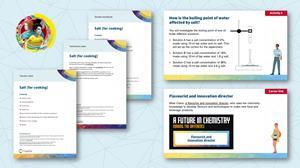Discover the changes to equilibrium, concentration and pH caused by adding salt to food
This session should take approximately one hour to complete in full. It was initially created for 11–14 year-old learners but can be adapted for other age groups. Use the resource in a sequence of timetabled lessons, STEM clubs, as part of an activity day.
The PowerPoint should be used to explain how salt affects the freezing and melting points of water, as well as to introduce the demonstration.
Learning objectives
- Explain some effects of using salt in cooking.
- Describe health concerns associated with salt in the diet.
Guidance notes
Use slides 3–12 of the PowerPoint to introduce the uses of salt in cooking and the health risks that it contributes to.
Introduce the demonstration ‘The effect of salt on ice/water equilibrium’ using side 13. Leave the demo to run while the learners complete Activities 1 and 2. The results can be looked at in the plenary.

This resource was developed as part of the Chemistry for All project. The project was set up to explore and address barriers to participation in UK chemistry undergraduate study through a longitudinal project. Read the findings relevant to teachers, outreach providers, education policymakers and parents in the summary report, or download the full research report.
In Activity 1, learners work in pairs to investigate how the concentration of salt in a solution affects the boiling point of the solution.
Learners will work in the same pairs in Activity 2 to see how salt solution affects the colour of green vegetables. They will compare their findings with the effects of vinegar and bicarbonate of soda.
Find the answers to the activities and discussion points for the demonstration in the teacher notes and slides.
Health and safety
Read our health and safety guidance and carry out a risk assessment before running any live practical.
The safety equipment suggested is in line with CLEAPSS requirements. For non-hazardous substances, wearing lab coats can help to protect clothes. The safety rules might be different where you live so it is worth checking local and school guidance.
More resources
- Further hone your 11–14 learners’ observation skills using microscale neutralisation and precipitation experiments.
- Extend your learners’ understanding of properties of matter differing between compounds and constituent elements using this demonstration.
- Review your 14–16 learners’ knowledge of quantitative chemistry using worksheets at differing levels of scaffolding to uncover knowledge gaps and misconceptions.
Careers
The Chemistry for All project found that recognising the value and importance of chemistry, and appreciating how chemistry can lead to interesting and well-paid jobs strongly related to learners’ future aspirations. Discover how chemistry can prepare learners to pursue apprenticeships, university courses and vocational routes and try our career options game from A Future in Chemistry.
After discussing the learners’ findings in Activity 2, introduce the group to careers by watching Claire’s video job profile on slide 20. She is a flavourist and innovation director who uses her chemistry knowledge to improve the taste of everyday foods and develop new products. Browse other job profiles to show learners how chemistry careers are making a difference in other areas too.
Find more activities like this, plus longer projects suitable for off-timetable days, science lessons or clubs on our Outreach resources hub.
Downloads
Salt (for cooking) student workbook
Editable handout | Word, Size 0.47 mbSalt (for cooking) student workbook
Handout | PDF, Size 0.38 mbSalt (for cooking) teacher notes
Editable handout | Word, Size 0.48 mbSalt (for cooking) teacher notes
Handout | PDF, Size 0.48 mbSalt (for cooking) technician notes
Editable handout | Word, Size 0.47 mbSalt (for cooking) technician notes
Handout | PDF, Size 0.39 mbSalt (for cooking) presentation slides
Presentation | PowerPoint, Size 2.4 mbSalt (for cooking) presentation slides
Presentation | PDF, Size 1.5 mb
Additional information
This resource was originally developed by the University of Reading to support outreach work delivered as part of the Chemistry for All project.



















No comments yet